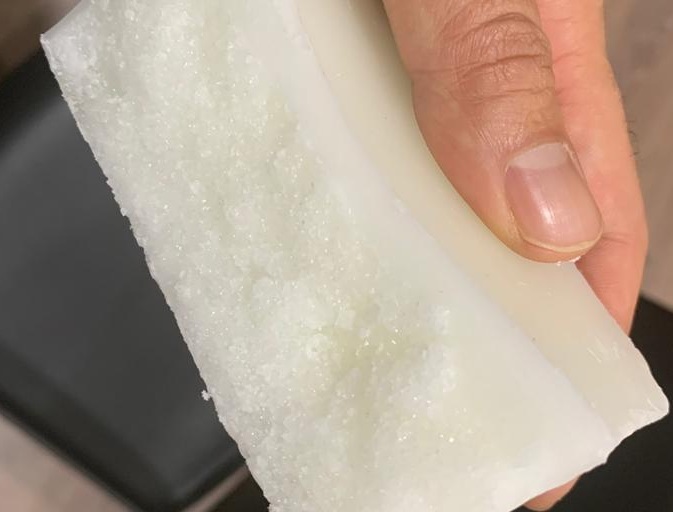Semi-Refined Paraffin Wax Definition
Semi-Refined Paraffin Wax is a solid substance derived from either one of Petroleum, Coal, or Shale. It constitutes of a mixture of Hydrocarbon molecules with anywhere between twenty and forty Carbon atoms. It has a very unreactive nature. These waxes are categorized by oil content and the degree of refinement. Semi-Refined Paraffin Waxes oil Content is between 1% to 10%.
Paraffin wax wacas first created in 1830 by the German chemist Karl von Reichenbach when he tried to develop the means to efficiently separate and refine the waxy substances naturally occurring in petroleum. Paraffin represented a major advance in the candlemaking industry, because it burned more cleanly and reliably, and was cheaper to manufacture than any other candle fuel. Paraffin wax initially suffered from a low melting point; however, this shortcoming was later remedied by the addition of harder stearic acid. The production of paraffin wax enjoyed a boom in the early 20th century as a result of the growth of the meatpacking and oil industries, which created paraffin and stearic acid as byproducts .

Manufacturing
The feedstock for paraffin is slack wax, which is a mixture of oil and wax, a byproduct from the refining of lubricating oil.
The first step in making paraffin wax is to remove the oil (de-oiling or de-waxing) from the slack wax. The oil is separated by crystallization. Most commonly, the slack wax is heated, mixed with one or more solvents such as a ketone and then cooled. As it cools, wax crystallizes out of the solution, leaving only oil. This mixture is filtered into two streams: solid (wax plus some solvent) and liquid (oil and solvent). After the solvent is recovered by distillation, the resulting products are called “product wax” (or “press wax”) and “foots oil”. The lower the percentage of oil in the wax, the more refined it is considered (semi-refined versus fully refined). The product wax may be further processed to remove colors and odors. The wax may finally be blended together to give certain desired properties such as melt point and penetration. Paraffin wax is sold in either liquid or solid form.
Semi-Refined Paraffin Wax Applications
- Candles, torches, tapers, matches, floor polishes.
- Car polishes, corrosion protectors.
- Electrical industries, cable filling compounds.
- Tires and rubber products, as ozone protection.
- Paper production.
- Carbon paper, crayons and pencils.
- Investment casting
- Anti-caking agent, moisture repellent, and dustbinding coatings for fertilizers
- Agent for preparation of specimens for histology
- Bullet lubricant – with other ingredients, such as olive oil and beeswax
- Phlegmatizing agent, commonly used to stabilise/desensitize high explosives such as RDX
- Crayons
- Solid propellant for hybrid rocket motors[22][23]
- Component of surfwax, used for grip on surfboards in surfing
- Component of glide wax, used on skis and snowboards
- Friction-reducer, for use on handrails and cement ledges, commonly used in skateboarding
- Ink. Used as the basis for solid ink different color blocks of wax for thermal printers. The wax is melted and then sprayed on the paper producing images with a shiny surface
- Microwax: food additive, a glazing agent with E number E905
- Forensic investigations: the nitrate test uses paraffin wax to detect nitrates and nitrites on the hand of a shooting suspect
- Antiozonant agents: blends of paraffin and micro waxes are used in rubber compounds to prevent cracking of the rubber; the admixture of wax migrates to the surface of the product and forms a protective layer. The layer can also act as a release agent, helping the product separate from its mould.
- Mechanical thermostats and actuators, as an expansion medium for activating such devices
- “Potting” guitar pickups, which reduces microphonic feedback caused from the subtle movements of the pole pieces
- “Potting” of local oscillator coils to prevent microphonic frequency modulation in low end FM radios.
- Textile manufacturing processes, such as that used for Eisengarn thread.
- Wax baths for beauty and therapy purposes
- Thickening agent in many paintballs
- Moisturiser in toiletries and cosmetics such as Vaseline.
- Prevents oxidation on the surface of polished steel and iron
- Phase change material for thermal energy storage
- MESSENGER (Mercury spacecraft) When the spacecraft was unable to radiate excessive heat.
- Manufacture of boiled leather armor and books
- Skateboard wax
- Paraffin microactuator
- Neutron radiation shielding
- Waterproofing agent for waxed cotton garments and commercially important in the early water proofing of ship sails.
- In Occupational and Physical therapies paraffin wax baths are used to warm and loosen connective tissue. They are mainly used in hand therapy.
- Used as the main additive in Log Sealers
Packing
Semi refined paraffin wax 1-1.5% oil content packing is 5 kg slabs; in the carton, pp (polypropylene) bags or gunny and there is the possibility of palatalizing too.
Analysis
Light grade
| Characteristic | Specification | Method |
| Form | Solid / slab | |
| Color | Transparent | Astm d-6045 |
| Oil content | Maximum 1.5% | Astm d-721 |
| Melting point | 58-60 ˚C | Astm d-87 |
| Flash point | Minimum 250 ˚C | Astm d-92 |
| Viscosity @ 100 ˚c | 16-18 | Astm d-445 |
| Congealing point | 58-60 ˚C | Astm d-938 |
Heavy grade
| Characteristic | Specification | Method |
| Form | Solid / slab | |
| Color | Transparent | Astm d-6045 |
| Oil content | Maximum 1.5% | Astm d-721 |
| Melting point | 62-64 ˚C | Astm d-87 |
| Flash point | Minimum 250 ˚C | Astm d-92 |
| Viscosity @ 100 ˚c | 16-18 | Astm d-445 |
| Congealing point | 60-62 ˚C | Astm d-938 |
